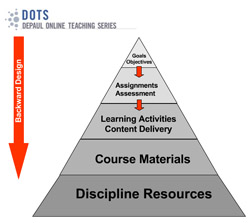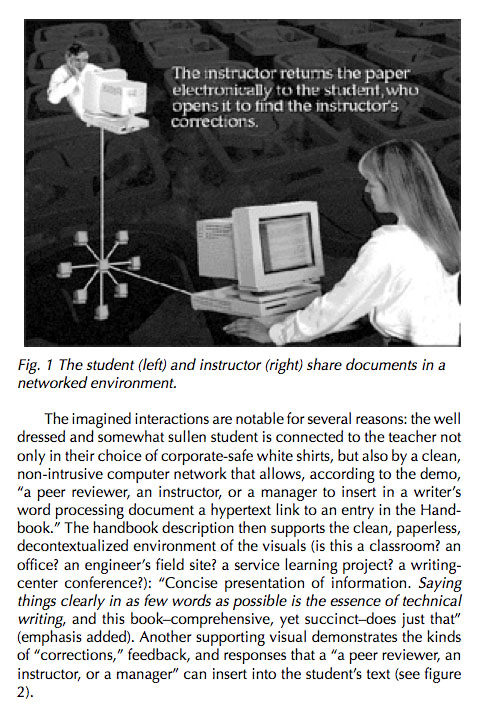Aligning Practice with Purpose:
Online Teaching & Learning
Post-DOTS Synthesis & Guidelines
WRD faculty, please also see our Teaching Online Courses in Writing, Rhetoric, & Discourse: WRD’s Mission Statement and Policies for on Online Learning on the networked W-drive on your computer. If you are off campus, you can access the W-drive via https://webdrive.depaul.edu.
Initial 2009 WRD DOTS Cohort:
- Tricia Hermes
- Tom McNamara
- Michael Moore
- Laura Friddle
- Ana Ribero
- Kristen Rozzell
- Christine Skolnik
- Deborah Weiner
Summer 2017 WRD DOTS Cohort:
- Dana Dunham
- Tricia Hermes
- Jason Kalin
- Erin MacKenna-Sandhir
- Michael Moore
- Margaret Poncin
- Justin Staley
- Pete Vandenberg
Our initial DOTS Cohort participated in DOTS training during the AQ 2009, and we have continued to develop materials, forms of support, and guidelines for faculty in FYW, WRD202, and WRD204.
Following our initial DOTS training sessions we continued to meet and to design our courses, and collaborated on many of  the activities listed below, finding many shared assumptions and approaches to teaching and technology that we
the activities listed below, finding many shared assumptions and approaches to teaching and technology that we
learned in DOTS with disciplinary expertise in Rhetoric & Composition and technology-mediated pedagogies.
We concluded that writing faculty with even just a passing interesting in technology-and-literacy issues — how they affect, inform, and shape each other — would be well served by teaching an online course, where we have our closest view of emerging relationships between technology and literacy. It is not like having your hand on the levers of power, but it is like having your hands on the levers of literacy. And it looks good on a curriculum vitae.
 Fundamental to excellent online courses and student success in WRD:
Fundamental to excellent online courses and student success in WRD:
- Engagement: the degree of attention, curiosity, interest, optimism, and passion that instructors can inspire and that students can reveal. (Reflected on “high-impact” practices that lead to increased engagement via projects that demand considerable time and effort.)
- Relationships, focusing especially on our FYW Learning Outcome, “collaborative and social aspects of writing processes”; the rhetorical dimensions of social presence
- Perspectives on inquiry: modeling for students via discussion-forums and project assignments how and why approaches to inquiry can be linked productively to their own questions and to writing
- Time management for both teachers and students
- Practice that allows for and encourages active learning
- Awareness of student diversity and student learning styles
- Awareness of student technology & literacy practices
We are happy to report that these are the same qualities of a good face-to-face course.
 Some strategies for course design & development:
Some strategies for course design & development:
- Alignment between measurable learning outcomes and course activities need to be made more explicit than many of us are used to doing in our face-to-face courses
- Weighing “seat time” versus outcomes and competencies (updated 2011)
- Ensuring opportunities for both student-to-student interactions and student-faculty interactions
- Preparing weekly and mid-weekly messages
- Integrating both print and digital readings
- Designing discussion-forum prompts that result in meaningful and generative responses (generative toward more complex, scaffolded paper topics and research projects, for example); see Ko & Rossen
- Arranging and guiding students through productive peer-review workshops
- Balancing constructivist methods with direct instruction: direct instruction refers to educational practices that are teacher-focused, skill-based, product-oriented, non-interactive, and highly prescribed. Constructivism refers to educational practices that are student-focused, meaning-based, process-oriented, interactive, and responsive to student interests. (Taber)
 What are the ideal candidate characteristics for teaching online?
What are the ideal candidate characteristics for teaching online?
- Excellent writing teachers who understand the importance of — and different approaches to — providing supportive formative and summative feedback to student writing via multiple platforms, in both low- and high-stakes contexts
- Resourcefulness and a willingness to try new approaches and methods
- Awareness of the “rhetoric of the interface” context and the role it plays in student-to-student and student-teacher interactions
- Awareness of student diversity and student learning styles
- Sensitivity to cultural and social values that students might bring to their understanding of technology and, by extension, to your classes
- Willingness to translate and revise materials, projects, and assignments from print expectations to digital expectations, including an active awareness of the social practices and student expectations underlying both; we looked at blogs, wikis, and other social media examples
- Willingness to share your planning, process, and outcomes with departmental colleagues
Added/updated AQ 2017 — ideal characteristics:
- Engaged and engaging pedagogies
- A good model of time management, both for faculty and students
- Ability to provide clear expectations
- Excellent problem-solving skills
- Willingness to experiment
- Unafraid to make mistakes
- Flexible
 Lessons Learned & Re-Learned
Lessons Learned & Re-Learned
- Designing and teaching a new online course for the first time can be time consuming. After you teach it the first time and revise for subsequent courses, the time commitment decreases
- An encouraging and responsive instructor presence — in its social and rhetorical embodiments — helps students rise to challenges, not unlike in face-to-face courses, where “participation” is also an ongoing issue
- An online community of inquiry is both desirable and achievable. Because technical and instructional aspects are not necessarily intuitive or analogous to the traditional classroom — the “interfaces” where students and teachers meet to do their work — we need to design projects, prompts, and opportunities for engagement and make clear to students the relationship between the design and the priority to engage: “In a traditional classroom, you might be used to X. In our class, we’ve set this up so that you can try Y.”
- Identifying ways to teach online so that we do not potentially widen the achievement gaps among students in different demographic groups: identifying students who might adapt well to the online context and those who might not; scaffolding online learning skills into online courses; incorporating early-warning systems into online courses in order to identify and intervene with students who are having difficulty adapting
- Teaching online is an excellent opportunity to think and to reflect on what we teach, how we teach it, and why. Numerous instructors report noticing both differences and similarities, and reflecting back on face-to-face classroom activities after seeing how they play out in online environments. For example, providing direct instruction in mixed communication modes of the oral, written, and visual projects: material and production differences can play to your advantage
- A teaching model that integrates both constructivist and directed modes (Delpit) of instruction — process and skills, for shorthand — can and should allow a teacher to teach from her own strengths, no matter the mode of delivery, toward programmatic learning outcomes
- Finally, always have a Plan B. Something will go wrong. It always does. A web resource you’d planned on using will disappear; a server will be down; your video won’t work; students will misunderstand what you mean by “upload” or “share”; three students will lose internet access for five days. Have a back-up plan. Working with new or unfamiliar technologies often requires professional skills such as resourcefulness, deep breathing, and humor.
 Workshop Resources
Workshop Resources
- Warnock: How & Why
- Warnock: Conversation: Online, Course ‘Talk’ Can Become Writing
- Palloff & Pratt: Building Online Learning Communities
- Chapter Two: Recontextualizing Community
- Chapter Four: Practical Considerations in Online Learning

